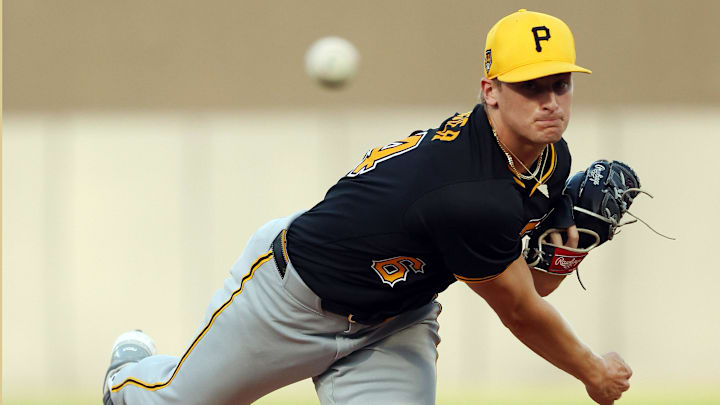Pittsburgh Pirates' pitching prospect Quinn Priester has looked sharp in Spring Training thus far. On top of that, he's showing off some improved stuff on the mound.
The Pittsburgh Pirates first-round pick from 2019, Quinn Priester, made his debut last season, and while it was a small sample size of 50 innings, Priester’s MLB career got off to a rather poor start. He had a 7.74 ERA, 6.74 FIP, and 1.70 WHIP, allowing over two home runs per nine innings, having just a 15.4% strikeout rate, and a mediocre 11.5% walk rate. Of the few positives in his brief MLB appearance last year, he had a ground ball rate over 50% at 52.4%, and his 26.7% HR/FB ratio indicates he got unlucky on some flyballs. That’s the second-highest HR/FB ratio of any rookie pitcher who threw at least 50 innings in their first big league season.
But Priester has come into Spring Training looking a lot sharper. His 5.11 ERA doesn’t do his performance justice. He has struck out ten batters in 12.1 innings while only allowing a single free pass. He’s also not allowing any hard contact. His 86.4 MPH exit velocity is the 9th best in Spring Training, while his 2.9% barrel rate is the 11th best among pitchers who have thrown at least 150 pitches and have allowed at least one barrelled-up batted ball.
Almost all of the earned runs Priester has given up came on a grand slam against the Philadelphia Phillies on March 10th, which arguably shouldn’t have even gotten to that point in the first place. Phillies’ utility man Edmundo Sosa blatantly leaned into an inside pitch, but the umpires didn’t catch it, causing a domino effect Priester couldn’t get out of. Aside from that one anomaly, Priester has looked sharp this preseason. A lot of that could be due to his improved stuff.
Priester is throwing an improved and harder slider. Last year, Priester’s slider averaged out at 85.3 MPH with 2486 RPM and 4.6 inches of glove-side movement. Priester has a similar amount of glove-side movement with 4.3 inches but is now throwing his slider at about 89 MPH with 2412 RPM. Priester definitely needed to rework his slider. Although he generated a whiff rate of 41.5% with it in the Majors last season, batters still hit the pitch with some authority with a below-average 89.5 MPH exit velocity and unimpressive .338 xwOBA.
Priester’s slider isn’t the only pitch that has gained some velocity. His four-seam fastball has also gained a tick. In 2023, he averaged out at 92.8 MPH but is now sitting at 93.9 MPH. About a quarter of his fastballs in ‘23 hit 94+ MPH. So far in Spring Training, nearly half of his four-seamers have touched 94+.
Along with his slider and four-seamer, Priester’s curveball is also being thrown slightly harder. Last year, he averaged 80.6 MPH with 2633 RPM but has sat at 81.3 MPH with 2533 RPM. Missing bats with his curve wasn’t the problem, as he had a 30.6% whiff rate, but batters still knocked the ball around the yard and had an ugly .415 xwOBA against Prister’s curveball.
Priester’s best pitch in 2023 was his change-up, which held batters to both a wOBA and xwOBA below .300 at .273 and .258, respectively, and a .316 slugging percentage. However, he’s made the pitch look even better in Spring Training. While in terms of velocity, he’s sitting around the same speed (89.1 MPH in ‘23 to 88.6 MPH ‘24 ST), his spin rate has dropped from 1504 RPM to 1422 RPM, which is the 14th lowest spin rate among pitchers who have thrown at least ten change-ups this spring. However, he’s added an additional 3.4 inches of drop (29.1 inches to 32.5 inches).
The only pitch that Priester hasn’t seen a major uptick in velocity or spin rate is his sinker or change-up. His sinker is sitting at 94 MPH, which is where he was sitting at the end of 2024 with 2060 RPM. While he’s lost some spin, he is still throwing the pitch with a similar amount of downward movement and arm-side break.
Priester’s Spring Training performance and the improvements he’s made have put him in serious contention for a starting rotation spot on the Pirates’ Major League roster.
I wouldn’t even be opposed to the Pirates attempting a six-man rotation to start the year so Priester can get some MLB starts in. He’s locating well, not allowing any quality contact, and is getting some swings and misses on top of that. He looks a lot more like the pitcher we saw in the minor leagues last season and the former first-round pick we were expecting.
